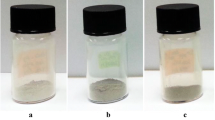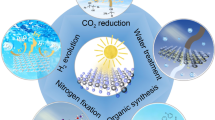Abstract
Wurzite ZnS:Mn nanorods are synthesized via a solvothermal method by using ethylenediamine and water as mixed solvent. The diameters of the nanorods increase and the lengths decrease with the Mn concentration. High resolution transmission electron microscopic images illustrate that a few cubic ZnS:Mn nanoparticles arise along with hexagonal nanorods on high Mn concentration. The samples set off yellow-orange emission at 590 nm, characteristic of 4T→6A1 transition of Mn2+ at Td symmetry in ZnS. Electron spin resonance spectrum of the nanorods shows that high Mn concentrations produce a broad envelope, whereas six-line hyperfine appears for lower Mn concentrations. These results together with the magnetization curves indicate that all the ZnS:Mn samples are paramagnetic even down to 4 K, which suggests that the ZnS:Mn is not suitable for dilute magnetic semiconductor.
Similar content being viewed by others
References
Wang M, Sun L, Fu X, et al. Synthesis and optical properties of ZnS:Cu(II) nanoparticles. Solid State Commun, 2000, 115(9): 493–496
Bala P, Valko M, Boldiz E, et al. Properties and reactivity of Mn-doped ZnS nanoparticles. Mater Lett, 2002, 57(1): 188–191
Nelkowski H, Pfützenreuter O, Schrittenlacher W. Comparison of luminescence and ESR-investigations in ZnS: Fe. J Liminsci, 1979, 20(4): 403–408
Ghosh S C, Thanachayanont C, Dutta J. Studies on zinc sulphide nanoparticles for field emission devices. In: Proceedings of the First ECTI Annual Conference (ECTI-CON 2004), Pattaya, Thailand, 2004. 145–148
Garlick J G F, Gibson A F. The luminescence of photo-conducting phosphors. J Opt Soc Am, 1949, 39(11): 935–940
Tang W, Cameron D C. Electroluminescent zinc sulphide devices produced by sol-gel processing. Thin Solid Film, 1996, 280(1): 221–226
Bredol M, Merikhi J. ZnS precipitation: Morphology control. J Mater Sci, 1998, 33(2): 471–476
Falcony C, Garcia M, Ortiz A. Luminescent properties of ZnS:Mn films deposited by spray pyrolysis. J Appl Phys, 1992, 72: 1525–1527
Bandaranayake R J, Lin J Y, Jiang H X. Synthesis and properties of Cd1−x MnxS diluted magnetic semiconductor ultrafine particles. J Magn Magn Mat, 1997, 169(3): 289–302
Pearce C I, Pattrick, Richard A D, et al. Electrical and magnetic properties of sulfides. Sulfide Mineral Geochem, 2006, 61: 127–180
Furdyna J K. Diluted magnetic semiconductors. J Appl Phys, 1988, 64: R29–R65
Ohno H. Making nonmagnetic semiconductors ferromagnetic. Science, 1998, 281: 951–956
Dietl T, Spalek J. Effect of fluctuations of magnetization on the bound magnetic polaron: Comparison with experiment. Phys ReV Lett, 1982, 48: 355–358
Taguchi S, Ishizumi A, Tayagaki T, et al. Mn-Mn couplings in Mn-doped CdS nanocrystals studied by magnetic circular dichroism spectroscopy. Appl Phys Lett, 2009, 94: 173101
Nielsen K-W, Philipp J B, Opel M A, et al. Ferromagnetism in Mn-doped ZnO due to impurity bands. Superlattices Microstruct, 2005, 37: 327–332
Sandratskii L M, Bruno P. Exchange interactions in ZnMeO (Me=Mn,Fe,Co,Ni): Calculations using the frozen-magnon technique. Phys Rev B, 2006, 73: 045203–045208
Hu P A, Liu Y Q, Fu L, et al. Self-assembled growth of ZnS nanobelt networks. J Phys Chem B, 2004, 108: 936–938
Lambe J, Kikuchi C. Paramagnetic resonance of CdTe: Mn and CdS: Mn. Phys Rev, 1960, 119: 1256–1260
Ishikawa Y. ESR spectra of exchange-coupled Mn2+ ions in ZnS and CdS. J Phys Soc Jpn, 1966, 21: 1473–1481
Hofmann D M, Hofstaetter A, Leib, U, et al. EPR and ENDOR investigations on CdS: Mn nanocrystals. J Cryst Growth, 1998, 184(2): 383–387
Brieler F J, Grundmann P, Fröba M, et al. Formation of Zn1−x MnxS nanowires within mesoporous silica of different pore sizes. J Am Chem Soc, 2004, 126(3): 797–807
Samelson H, Lempicki A. Fluorescence of Cubic ZnS:Cl, Crystals. Phys Rev, 1962, 125(3): 901–909
Sooklal K, Cullum B S, Angel S M, et al. Photophysical properties of ZnS nanoclusters with spatially localized Mn2+. J Phys Chem, 1996, 100(10): 4551–4555
Author information
Authors and Affiliations
Corresponding author
Additional information
Recommended by ZHANG YuHeng (CAS Academician)
Rights and permissions
About this article
Cite this article
Zuo, M., Tan, S., Li, G. et al. Structure characterization, magnetic and photoluminescence properties of Mn doped ZnS nanocrystalline. Sci. China Phys. Mech. Astron. 55, 219–223 (2012). https://doi.org/10.1007/s11433-011-4595-3
Received:
Accepted:
Published:
Issue Date:
DOI: https://doi.org/10.1007/s11433-011-4595-3




